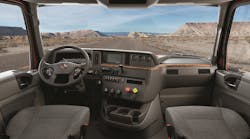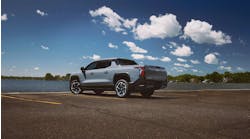Whether it’s a long haul or a short drive, truck driving is one of the hardest jobs on the body. Drivers often suffer from injuries and accidents that could be prevented by proper ergonomics.
Things like sitting too close to the steering wheel can lead to neck, shoulder, and back pain attributed to extended hours on the road. The profession also lends itself to injuries from pushing, pulling, lifting, and/or bending.
Employees at the University of Michigan Transportation Research Institute have conducted studies of truck driver posture. The effects of cab geometry and driver attributes have been quantified through statistical analysis of data measured in laboratory mockups and in trucks driven on the road.
The results are used by truck manufacturers to design more accommodating, safer truck cabs along with introducing more ergonomic solutions that not only increase vehicle safety but also improve driver comfort.
Fleets and drivers are also more aware of possible solutions, such as selecting a vehicle that matches the requirements for the size of the driver’s body and any physical limitations the driver may have.
Nic Signorini, director of supply management at Ryder System Inc., points out that OEMs have made a deliberate effort to improve the overall design and ergonomic features in the products they offer. That includes anything from larger windshields and windows to improve visibility to adjustable features such as tilt and telescoping steering wheels, seat belts, cup holders, and controls.
“It provides drivers access to what they need with as little effort as possible while avoiding fatigue and distraction,” Signorini said. “Having a wide range of seating options is also very important given the long hours of service that drivers put in.”
Ryder configures a comfortable and adjustable air-ride, hi-back seat by default and offers customers options to upgrade to seats with even more flexibility and features.
“Drivers spend a lot of time in the cab, and driver stature and body shape can vary greatly,” Signorini said. “Offering adjustable settings so that drivers can optimize their driving positions to maximize comfort can help minimize fatigue and bad posture. Features like adjustable damping, air lumbar support, back cyclers, and heating elements can also help increase comfort and avoid injuries.”
Better environment
To meet its cab ergonomic goals of providing increased safety and comfort for drivers, Dupré Logistics has spec’d its trucks with grab handles as well as multi-position, air-ride seats with lumbar support, telescoping steering wheels, and tilt steering wheels, said Al Lacombe, vice president of safety and risk management.
Lacombe said these features have increased driver comfort and lowered fatigue, the goal of every ergonomically designed truck.
“Driver satisfaction is critical,” said Kelly Gedert, director of product marketing for Freightliner Trucks and Detroit Components. “In developing our vehicles, we consider not only how drivers operate their vehicles, but how the truck is part of their lifestyle.”
Improvements have been made over the last several years to make cab interiors safer and more appealing to drivers.
Gedert added: “When we introduced the new Cascadia, we gathered input from fleet customers and owner-operators to ensure we had a deep understanding of their priorities and challenges. Features such as large windshields, strategically placed mirrors, larger door openings, A and B pillar grab handles, and the placement of gauges and switches all benefit driver safety.”
Other ergonomic features in the new Cascadia include the steering gear being located further forward to improve precision and a newly designed wraparound dashboard with switches and steering wheel controls so drivers can work without leaning and stretching.
Driver input
Volvo Trucks North America performs studies in the field with real drivers, listening to their needs and considering design changes, said Allison Athey, product marketing manager.
“Armed with the results of ongoing ergonomic studies, our engineers and designers made all aspects of our cab interiors as dynamic and flexible as possible,” she said. “We study all shapes and sizes of body types to get a vast and all-encompassing sample, covering the full range of a human body.”
The result has been an increased focus on ergonomics, coupled with ease of use and increased safety. For example, Volvo has focused on the best ways to help drivers keep their hands on the wheel with all controls in easy reach.
Volvo’s Active Driver Assist safety system comes standard with a heads-up display. As a result, if a collision is imminent, the display provides a visual, lighted warning appearing on the windshield, alerting the driver immediately.
Additionally, fleets that have switched to the Volvo I-Shift, the company’s automated manual transmission, have reported a reduction in accidents because of reduced distractions, Athey said.
Ergonomics basics
“Ergonomics start with entering and exiting the vehicle,” explained Navistar’s Jim Nachtman, heavy-duty marketing manager.
For the company’s International LT Series, a reduced step height, offset steps, and three points of contact make it easier on drivers. While in motion, pedestal mirrors are placed forward for better visibility while reducing neck turn angles and driver neck fatigue. A more sloping hood improves forward visibility, and a reduced belt line on the doors allows the driver to see 20 in. closer to the side of the vehicle.
Additionally, the stalk shifter used with automated manual transmissions and automatic transmissions is intuitive to use for gear selection, manual mode, and engine brake control. Switches and trailer controls are located based on frequency of use, placing the most important ones close to the driver.
Once the engine is turned off, increased legroom allows the driver to easily pivot from the driver seat to the sleeper.
“These improvements and others make life on the road more comfortable and productive,” Nachtman noted.
According to Patrick Dean, chief engineer at Kenworth Truck Co., the truck maker has been continually engaging with drivers and fleets monitoring trends in society and technology.
Since drivers spend so much of their time behind the wheel, fleets are becoming more aware of the importance of choosing premium seats. “Kenworth’s GT700 series of seats has an advanced height/weight independent suspension system,” Dean said. “With this system, drivers get an optimal ride and will never bottom out regardless of their preferred height setting or their weight.”
An adjustable shock allows them to fine-tune the dampening characteristics to their preference of firm or soft. It also helps provide comfort for a wider range of sizes, from a 5-ft. female driver to a 6-ft., 4-in. male driver.
The core suspension is based on an advanced seat platform and is significantly more durable and greatly restricts lateral movement compared to previous seats, added Kurt Swihart, Kenworth’s marketing director.
As these options continue to expand, helping to prevent many injuries, it does not change that under OSHA regulations, employers are responsible for providing a workplace free from recognized hazards. That makes it all the more reason fleets, drivers and manufacturers should and do work together to improve ergonomics.



